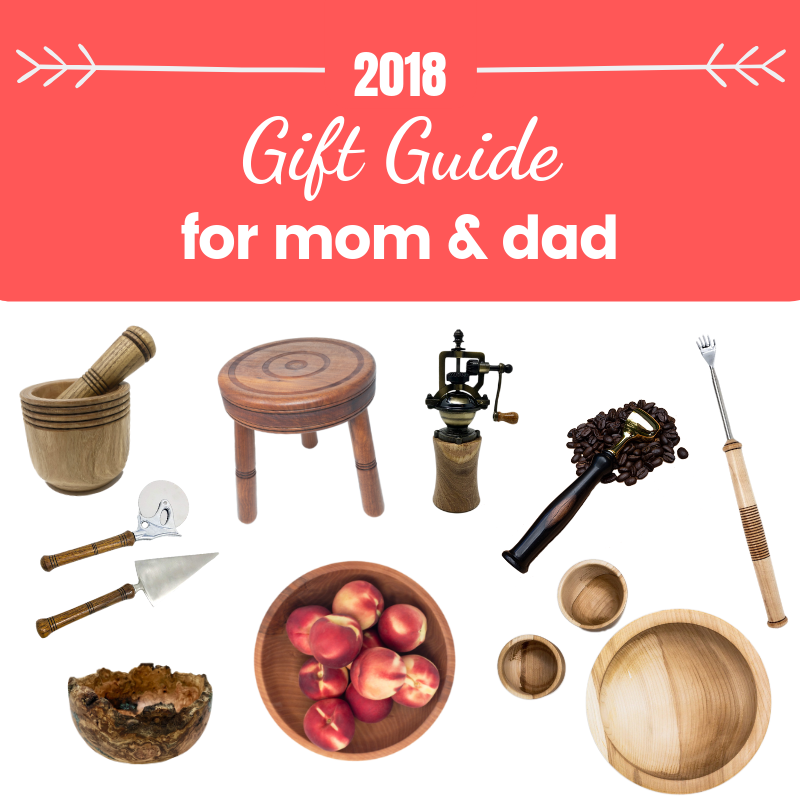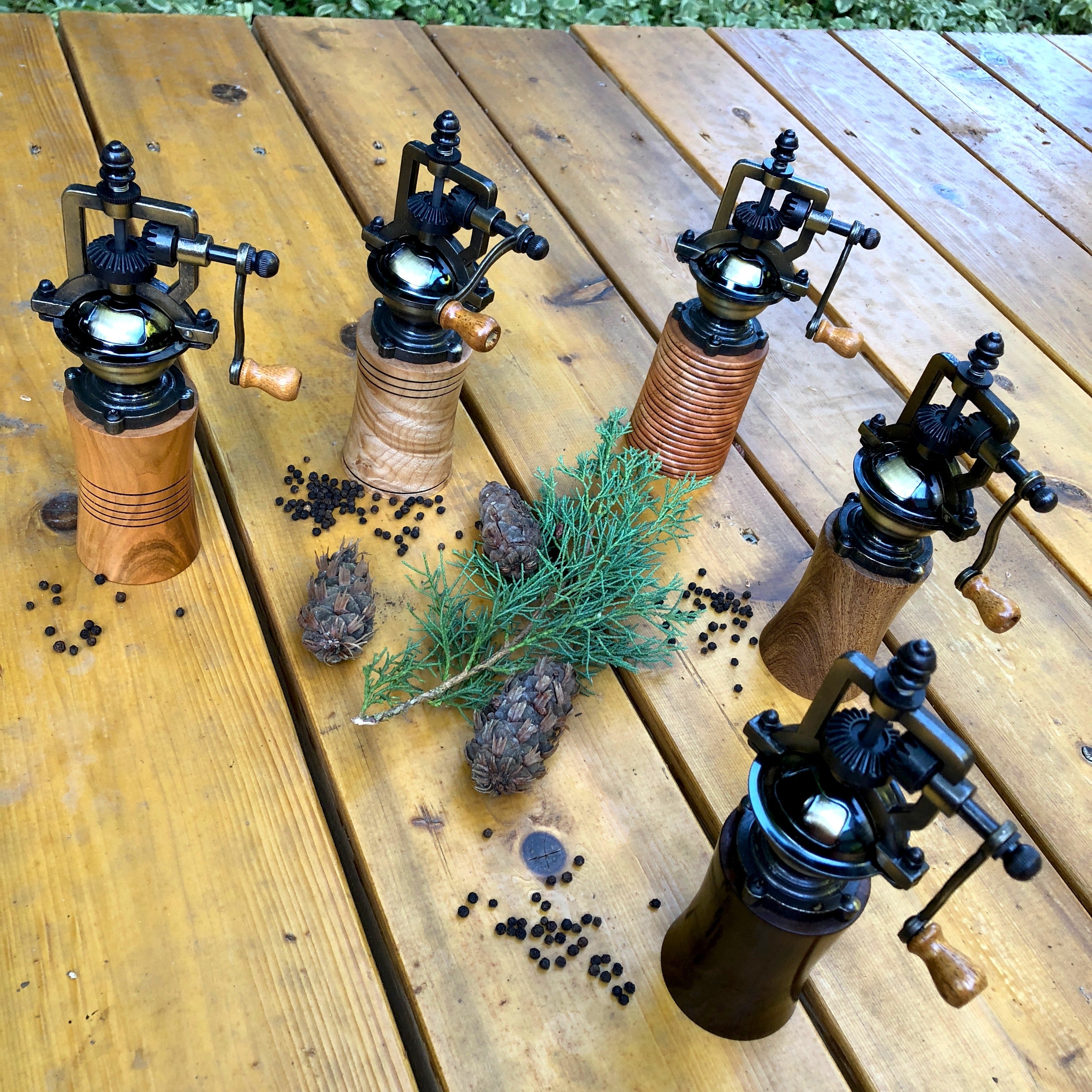Platters Platters Platters
Ready for even more fun at the lathe? Try turning a platter!!!
So…just what is a platter? And when is a bowl a platter or vice-versa? And how about plates? Is a platter a plate? This is so confusing….
Yes, there are differences…as well as similarities between all three.
So: a PLATE is usually used to hold food that is being eaten by an individual. A PLATTER is used to hold or present food for serving and is similar to a plate in that it is a shallow and flat vessel, but is usually larger in diameter than a "standard" sized plate (usually 13-inches in diameter or more). Like plates, platters typically incorporate an outer RIM as part of the design. The DEPTH is usually given as less than 1/5th (or 20%) of the diameter. A BOWL usually has a depth of about 1/3 (or greater) of the diameter, and bowls usually do NOT incorporate outer rims as part of the design, although some may have an inner rim.
Ready to begin?
TOOLS:
- Spindle gouge
- Bowl gouge
- Beading Tool (optional)
- Texturing Tool (optional)
- Scroll Chuck
- Screw Chuck or Live Center/Drive Center
- Sanding/Finishing materials
MATERIALS:
Wood of choice: Figured, Strong Grain Patterns, Colors
If the blank is square, insure that the diagonal measurement (corner to corner) is LESS THAN the maximum diameter permitted by your lathe. If not, cut the corners off as required or bandsaw the blank into a circle. NOTE: Yes, the platter can have a SQUARE RIM if you so desire.
MOUNT the blank on the lathe using either a SCREW CHUCK or by mounting between centers using LIVE CENTER/DRIVE CENTER. Regardless of which method is used, it is recommended that the tail stock with live center be engaged during the roughing out process. If working between centers, make sure that the blank is square to the lathe in both planes so that it rotates evenly.
Adjust the tool rest to the appropriate position and lock it in place. Adjust the speed to a safe rate.
Using the BOWL GOUGE, insure that the blank is round. Decide at this time the width and thickness of the rim, and remove the necessary material from the side of the blank that is toward the tail stock. Keep in mind that if there is going to be decorative work on the upper surface of the rim (such as beads, vees, coves etc.) you must leave enough thickness to accommodate them. The rim can be flat or curved…you make the artistic decision. Curved rims should not, however, be so curved that they will become the resting surface for the platter….how would you pick it up?
After creating the under surface for the rim, develop the bottom shape and foot. A gentle OGEE shape is quite pleasing, as is a simple single curve. Straight lines are not as pleasing to the eye. The bottom should flow into the foot. The good news is that when turning platters, a foot height of only 1/8th inch is enough for the scroll chuck to safely hold. The foot does not necessarily have to be the TENON for the chuck. The platter foot DIAMETER is usually the same as for a bowl (1/3 the major diameter); however, the TENON diameter for the scroll chuck can be less than that of the foot. Remember, however, that tenon strength is a function of diameter, not height. So if your scroll chuck jaws can accommodate a diameter of 3-inches plus….use that.
REFINE the bottom surfaces as necessary, sand and apply the finish of your choice.
Remove the blank from the screw chuck ( or drive center/live center), mount the scroll chuck on the lathe and then mount the blank into the scroll chuck. CHECK AND VERIFY that the blank is running square and true in the chuck. Again use the tail stock and live center. A CUP CENTER on the live center is recommended.
DEVELOP and refine the upper surface of the rim and add any decorative touches you deem appropriate. Taking note of the width of the rim on the underside, ADD the amount of thickness the platter will be. Transfer this information and make a mark at the appropriate place on the upper surface. This mark is the transition point from the rim to the interior of the platter. If you make a mistake at this calculation, two possibilities exist. You will either cut off the rim as you transition into the inside of the platter or the wall thickness will be excessively thick. Keep in mind that platters are usually NOT exercises in thin turning, and that rim thickness is usually carried throughout the vessel.

FREQUENTLY check and verify thickness and depth. The interior should have a gentle curve without humps and dips, no crown or "pothole" at the center. Remove the tail stock as you approach the final cuts into the center. A conventional gouge (that is, one that does NOT have a fingernail grind, usually does a beautiful job of making your last "hero" cut. Keep in mind that it is better to make 200 light cuts than one "OH SHI…"
Use the bevel, go slow, keep the tool under control at all times, keep the tool sharpened and life is good.
SAND AND FINISH the inside.
Reverse the platter and remove the tenon. Sand and finish, sign your name…another FAMILY HEIRLOOM!!!




24 comments
klayline@gmail.com
카지노사이트 https://joinlive77.com/
바카라사이트 https://joinlive77.com/
온라인카지노 https://joinlive77.com/
온라인바카라 https://joinlive77.com/
온라인슬롯사이트 https://joinlive77.com/
카지노사이트게임 https://joinlive77.com/
카지노사이트검증 https://joinlive77.com/
카지노사이트추천 https://joinlive77.com/
안전카지노사이트 https://joinlive77.com/
안전카지노사이트도메인 https://joinlive77.com/
안전한 카지노사이트 추천 https://joinlive77.com/
바카라사이트게임 https://joinlive77.com/
바카라사이트검증 https://joinlive77.com/
바카라사이트추천 https://joinlive77.com/
안전바카라사이트 https://joinlive77.com/
안전바카라사이트도메인 https://joinlive77.com/
안전한 바카라사이트 추천 https://joinlive77.com/
http://old.roofnet.org/external.php?link=https://joinlive77.com/
http://www.forum-wodociagi.pl/system/links/3a337d509d017c7ca398d1623dfedf85.html?link=https://joinlive77.com/
http://www.bucatareasa.ro/link.php?url=https://joinlive77.com/
http://maximov-design.ru/link.php?go=https://joinlive77.com/
http://mosprogulka.ru/go?https://joinlive77.com/
https://uniline.co.nz/Document/Url/?url=https://joinlive77.com/
http://count.f-av.net/cgi/out.cgi?cd=fav&id=ranking_306&go=https://joinlive77.com/
https://tracker.onrecruit.net/api/v1/redirect/?redirect_to=https://joinlive77.com/
http://slipknot1.info/go.php?url=https://joinlive77.com/
https://www.donbosco.it/common/mod_30_conta.asp?id=6&link=https://joinlive77.com/
http://samaraenergo.ru/bitrix/rk.php?goto=https://joinlive77.com/
https://www.samovar-forum.ru/go?https://joinlive77.com/
http://san-house.ru/bitrix/rk.php?goto=https://joinlive77.com/
https://sbereg.ru/links.php?go=https://joinlive77.com/
http://staldver.ru/go.php?go=https://joinlive77.com/
http://www.stalker-modi.ru/go?https://joinlive77.com/
https://www.star174.ru/redir.php?url=https://joinlive77.com/
https://staten.ru/bitrix/rk.php?goto=https://joinlive77.com/
https://stav-geo.ru/go?https://joinlive77.com/
http://stopcran.ru/go?https://joinlive77.com/
http://studioad.ru/go?https://joinlive77.com/
http://supcourt.ru/bitrix/redirect.php?goto=https://joinlive77.com/
http://swepub.kb.se/setattribute?language=en&redirect=https://joinlive77.com/
https://www.licnioglasi.org/index.php?thememode=full;redirect=https://joinlive77.com/
http://www.rexart.com/cgi-rexart/al/affiliates.cgi?aid=872&redirect=https://joinlive77.com/
http://www2.smartmail.com.ar/tl.php?p=hqf/f94/rs/1fp/4c0/rs//https://joinlive77.com/
http://catalogo.garrahan.edu.ar/cgi-bin/koha/tracklinks.pl?uri=https://joinlive77.com/
http://elsy.at/elearningdownload.php?link=https://joinlive77.com/
http://www.erotikplatz.at/redirect.php?id=939&mode=fuhrer&url=https://joinlive77.com/
http://www.imsnet.at/LangChange.aspx?uri=https://joinlive77.com/
https://store-pro.ru/go?https://joinlive77.com/
https://strelmag.ru/bitrix/rk.php?goto=http://story-bet.xyz/index.php/2022/07/13/why-paypal-accepting-bitcoin-is-major-news-for-online-gamblers/
https://stroim100.ru/redirect?url=http://story-bet.xyz/index.php/2022/07/13/why-paypal-accepting-bitcoin-is-major-news-for-online-gamblers/
https://stroysar.ru/links.php?go=http://story-bet.xyz/index.php/2022/07/13/why-paypal-accepting-bitcoin-is-major-news-for-online-gamblers/
http://stroysoyuz.ru/bitrix/rk.php?goto=http://story-bet.xyz/index.php/2022/07/13/why-paypal-accepting-bitcoin-is-major-news-for-online-gamblers/
http://smile.wjp.am/link-free/link3.cgi?mode=cnt&no=8&hpurl=http://story-bet.xyz/index.php/2022/07/13/why-paypal-accepting-bitcoin-is-major-news-for-online-gamblers/
https://oxleys.app/friends.php?q=http://story-bet.xyz/index.php/2022/07/13/why-paypal-accepting-bitcoin-is-major-news-for-online-gamblers/
https://www.kyoto-good.jp/ad.php?url=http://story-bet.xyz/index.php/2022/07/13/why-paypal-accepting-bitcoin-is-major-news-for-online-gamblers/
https://analytics.bluekai.com/site/16231?phint=event=click&phint=campaign=BRAND-TAB&phint=platform=search&done=http://story-bet.xyz/index.php/2022/07/13/why-paypal-accepting-bitcoin-is-major-news-for-online-gamblers/
https://temptationsaga.com/buy.php?url=http://story-bet.xyz/index.php/2022/07/13/why-paypal-accepting-bitcoin-is-major-news-for-online-gamblers/
https://splash.hume.vic.gov.au/analytics/outbound?url=http://story-bet.xyz/index.php/2022/07/13/why-paypal-accepting-bitcoin-is-major-news-for-online-gamblers/
https://uk.kindofbook.com/redirect.php/?red=http://story-bet.xyz/index.php/2022/07/13/why-paypal-accepting-bitcoin-is-major-news-for-online-gamblers/
https://kakaku-navi.net/items/detail.php?url=http://story-bet.xyz/index.php/2022/07/13/why-paypal-accepting-bitcoin-is-major-news-for-online-gamblers/
http://rzngmu.ru/go?http://story-bet.xyz/index.php/2022/07/13/why-paypal-accepting-bitcoin-is-major-news-for-online-gamblers/
https://s-online.ru/bitrix/redirect.php?goto=http://story-bet.xyz/index.php/2022/07/13/why-paypal-accepting-bitcoin-is-major-news-for-online-gamblers/
https://www.samovar-forum.ru/go?http://story-bet.xyz/index.php/2022/07/13/why-paypal-accepting-bitcoin-is-major-news-for-online-gamblers/
https://adengine.old.rt.ru/go.jsp?to=http://story-bet.xyz/index.php/2022/07/13/why-paypal-accepting-bitcoin-is-major-news-for-online-gamblers/
http://www.rucem.ru/doska/redirect/?go=http://story-bet.xyz/index.php/2022/07/13/why-paypal-accepting-bitcoin-is-major-news-for-online-gamblers/
] Amoxicillin 500 Mg btp.edkl.woodwhirled.com.bem.ql http://mewkid.net/when-is-xuxlya2/